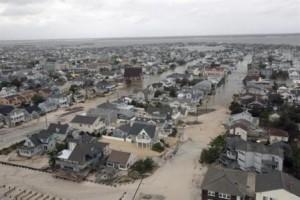Hurricane SandyHousing problems loom large in post-Sandy New York City
As a result of Hurricane Sandy, New York City is now dealing with more than 40,000 people who do not have homes to go back to; Mayor Michael Bloomberg said that the number is the worst possible case given by the Department of Housing and Urban Development (HUD), and 20,000 is a more realistic assessment of how many people are homeless; as of late Sunday, 182,000 residents of New York, New Jersey, and Connecticut have applied for disaster assistance, and $158 million has been approved

Floods and fire follow in Sandy's wake // Source: radiord.com.ar
As a result of Hurricane Sandy, New York City is now dealing with more than 40,000 people who do not have homes to go back to. Mayor Michael Bloomberg said that the number is the worst possible case given by the Department of Housing and Urban Development (HUD), and 20,000 is a more realistic assessment of how many people are homeless. Whatever the number is, most of the people who are now living in shelters or in the streets are residents of public housing.
“We don’t have a lot of empty housing in this city,” Bloomberg said at a news conference on Sunday. “We are not going to let anybody go sleeping in the streets or go without blankets, but it’s a challenge, and we’re working on that as fast as we can.”
The New York Times reports that in some cases the trailers provided by the Federal Emergency Management Agency(FEMA) after Hurricane Katrina will be used. Craig Fugate, the director of the agency, said that for now, most displaced people will be housed in hotels and apartments, but in areas like Long Island, which features many single family homes and large apartment blocks, there is a shortage of housing options.
“It has got to make sense for the neighborhood,” Fugate told the Times, adding that it was up to the states to request the trailers. “We are going to bring all potential housing solutions and look at what works best for each neighborhood.”
Power has been restored to most of the city and the subway system is running most lines into and through Manhattan, but in many areas outside New York there is still no power, and there is shortage of fuel as well.. According to the Energy Department, 1.8 million people are still without power. Included in those numbers are 900,000 are in New Jersey and 280,000 in Long Island.
As of late Sunday, 182,000 residents of New York, New Jersey, and Connecticut have applied for disaster assistance, and $158 million has been approved.
It is still unknown how many people will need housing, whether temporary or permanent. Those with no homes to return to will have to find a new place to live, which could prove very difficult
“We lost a lot of housing here in New Jersey,” Janet Napolitano, DHS secretary, said at a press conference in Hoboken with New Jersey governor Chris Christie. “We don’t even know yet which houses are reparable.”
Another factor is the weather; while the rain and hard winds have stopped, it is getting colder by the day as the year comes to a close. New York has opened heating shelters and is also passing out blankets to residents without electricity.
There is some good news as the gas crisis appears to be coming to an end. As of Sunday, 27 percent of gas stations in the city reported being out of fuel, compared to 67 percent on Friday. The Port Authority of New York and New Jersey announced that Port Elizabeth, New Jersey has reopened on Sunday to receive its first shipments, but other seaports remained closed.
Also, schools in New York have reopened this week, and according to Bloomberg, 96 percent of school buses are operating. Students at schools which are closed will be sent to other locations, though Bloomberg has said that keeping everyone informed has been a challenge.
The election will provide another significant challenge. Almost 143,000 voters in the New York will be assigned to polling sites outside their districts, and Bloomberg hopes that the New York Board of Elections, which he has criticized in the past for mismanagement, would be prepared.
Asked if he thought the board was up to the task, he replied: “I have absolutely no idea.”
